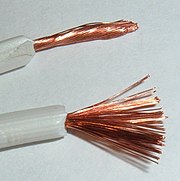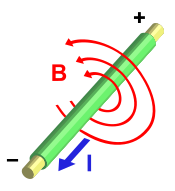Electric current
From Wikipedia, the free encyclopedia
| This article needs additional citations for verification. Please help improve this article by adding reliable references (ideally, using inline citations). Unsourced material may be challenged and removed. (March 2009) |
Electric current is the flow of electric charge.[1] The electric charge may be either electrons or ions.[2]
The SI unit of electric current intensity is the ampere. Electric current is measured using an ammeter.[3]
Contents |
[edit] Current in a metal wire
A solid conductive metal contains a large population of mobile, or free, electrons. These electrons are bound to the metal lattice but not to any individual atom. Even with no external electric field applied, these electrons move about randomly due to thermal energy but, on average, there is zero net current within the metal. Given a plane through which the wire passes, the number of electrons moving from one side to the other in any period of time is on average equal to the number passing in the opposite direction.
When a metal wire is connected across the two terminals of a DC voltage source such as a battery, the source places an electric field across the conductor. The moment contact is made, the free electrons of the conductor are forced to drift toward the positive terminal under the influence of this field. The free electrons are therefore the current carrier in a typical solid conductor. For an electric current of 1 ampere, 1 coulomb of electric charge (which consists of about 6.242 × 1018 electrons) drifts every second through any plane through which the conductor passes.
For a steady flow, the current I in amperes can be calculated with the following equation:
where
- Q is the electric charge in coulombs transferred
- t is the time in seconds
More generally, electric current can be represented as the time rate of change of charge, or
 .
.
[edit] Electric currents in other media
In metallic solids, electricity flows by means of electrons, from lower to higher electrical potential. In other media, any stream of charged objects may constitute an electric current.
In a vacuum, a beam of ions or electrons may be formed. In other conductive materials, the electric current is due to the flow of both positively and negatively charged particles at the same time. In still others, the current is entirely due to positive charge flow. For example, the electric currents in electrolytes are flows of electrically charged atoms (ions), which exist in both positive and negative varieties. In a common lead-acid electrochemical cell, electric currents are composed of positive hydrogen ions (protons) flowing in one direction, and negative sulfate ions flowing in the other. Electric currents in sparks or plasma are flows of electrons as well as positive and negative ions. In ice and in certain solid electrolytes, the electric current is entirely composed of flowing ions. In a semiconductor it is sometimes useful to think of the current as due to the flow of positive "holes" (the spots that should have an electron to make the conductor neutral). This is the case in a p-type semiconductor.
[edit] Current density
Current density is a measure of the density of an electric current. It is defined as a vector whose magnitude is the electric current per cross-sectional area. In SI units, the current density is measured in amperes per square meter.
[edit] The drift speed of electric charges
The mobile charged particles within a conductor move constantly in random directions, like the particles of a gas. In order for there to be a net flow of charge, the particles must also move together with an average drift rate. Electrons are the charge carriers in metals and they follow an erratic path, bouncing from atom to atom, but generally drifting in the direction of the electric field. The speed at which they drift can be calculated from the equation:
where
- I is the electric current
- n is number of charged particles per unit volume
- A is the cross-sectional area of the conductor
- v is the drift velocity, and
- Q is the charge on each particle.
Electric currents in solids typically flow very slowly. For example, in a copper wire of cross-section 0.5 mm2, carrying a current of 5 A, the drift velocity of the electrons is of the order of a millimetre per second. To take a different example, in the near-vacuum inside a cathode ray tube, the electrons travel in near-straight lines at about a tenth of the speed of light.
Any accelerating electric charge, and therefore any changing electric current, gives rise to an electromagnetic wave that propagates at very high speed outside the surface of the conductor. This speed is usually a significant fraction of the speed of light, as can be deduced from Maxwell's Equations, and is therefore many times faster than the drift velocity of the electrons. For example, in AC power lines, the waves of electromagnetic energy propagate through the space between the wires, moving from a source to a distant load, even though the electrons in the wires only move back and forth over a tiny distance.
The ratio of the speed of the electromagnetic wave to the speed of light in free space is called the velocity factor, and depends on the electromagnetic properties of the conductor and the insulating materials surrounding it, and on their shape and size.
The nature of these three velocities can be illustrated by an analogy with the three similar velocities associated with gases. The low drift velocity of charge carriers is analogous to air motion; in other words, winds. The high speed of electromagnetic waves is roughly analogous to the speed of sound in a gas; while the random motion of charges is analogous to heat - the thermal velocity of randomly vibrating gas particles.
[edit] Ohm's law
Ohm's law predicts the current in an (ideal) resistor (or other ohmic device) to be the applied voltage divided by resistance:
where
- I is the current, measured in amperes
- V is the potential difference measured in volts
- R is the resistance measured in ohms
[edit] Conventional current
A flow of positive charge gives the same electric current as an opposite flow of negative charge. Thus, opposite flows of opposite charges contribute to a single electric current. For this reason, the polarity of the flowing charges can usually be ignored during measurements. All the flowing charges are assumed to have positive polarity, and this flow is called conventional current. Conventional current represents the net effect of the current flow, without regard to the sign of the charge of the objects carrying the current.
In solid metals such as wires, the positive charge carriers are immobile, and only the negatively charged electrons flow. Because the electron carries negative charge, the electron motion in a metal is in the direction opposite to that of conventional (or electric) current.
[edit] Examples
Natural examples include lightning and the solar wind, the source of the polar auroras (the aurora borealis and aurora australis). The artificial form of electric current is the flow of conduction electrons in metal wires, such as the overhead power lines that deliver electrical energy across long distances and the smaller wires within electrical and electronic equipment. In electronics, other forms of electric current include the flow of electrons through resistors or through the vacuum in a vacuum tube, the flow of ions inside a battery or a neuron, and the flow of holes within a semiconductor.
[edit] Electromagnetism
Electric current produces a magnetic field. The magnetic field can be visualized as a pattern of circular field lines surrounding the wire.
Electric current can be directly measured with a galvanometer, but this method involves breaking the circuit, which is sometimes inconvenient. Current can also be measured without breaking the circuit by detecting the magnetic field associated with the current. Devices used for this include Hall effect sensors, current clamps, current transformers, and Rogowski coils.
[edit] Reference direction
When solving electrical circuits, the actual direction of current through a specific circuit element is usually unknown. Consequently, each circuit element is assigned a current variable with an arbitrarily chosen reference direction. When the circuit is solved, the circuit element currents may have positive or negative values. A negative value means that the actual direction of current through that circuit element is opposite that of the chosen reference direction.
[edit] Electrical safety
The most obvious hazard is electrical shock, where a current passes through part of the body. It is the amount of current passing through the body that determines the effect, and this depends on the nature of the contact, the condition of the body part, the current path through the body and the voltage of the source. While a very small amount can cause a slight tingle, too much can cause severe burns if it passes through the skin or even cardiac arrest if enough passes through the heart. The effect also varies considerably from individual to individual.
Accidental electric heating can also be dangerous. An overloaded power cable is a frequent cause of fire. A battery as small as an AA cell placed in a pocket with metal coins can lead to a short circuit heating the battery and the coins which may inflict burns. NiCad, NiMh cells, and lithium batteries are particularly risky because they can deliver a very high current due to their low internal resistance.
[edit] See also
- Alternating current
- Current density
- Direct current
- Electrical conduction for more information on the physical mechanism of current flow in materials
- Electricity
- Four-current
- History of electrical engineering
- Hydraulic analogy
- SI electromagnetism units
[edit] References
- ^ Lakatos, John; Oenoki, Keiji; Judez, Hector; Oenoki, Kazushi; Hyun Kyu Cho (March 1998). "Learn Physics Today!". written at Lima, Peru. Colegio Franklin D. Roosevelt. http://library.thinkquest.org/10796/ch13/ch13.htm. Retrieved on 2009-03-10.
- ^ Anthony C. Fischer-Cripps (2004). The electronics companion. CRC Press. p. 13. ISBN 9780750310123. http://books.google.com/books?id=3SsYctmvZkoC&pg=PA13&dq=positive-ions+carrier+current+charge+electrons&lr=&as_brr=3&as_pt=ALLTYPES&ei=RbfWSZnELJeSkASZvbi-Bg.
- ^ Lakatos, John; Oenoki, Keiji; Judez, Hector; Oenoki, Kazushi; Hyun Kyu Cho (March 1998). "Learn Physics Today!". written at Lima, Peru. Colegio Franklin D. Roosevelt. http://library.thinkquest.org/10796/ch13/ch13.htm. Retrieved on 2009-03-10.








